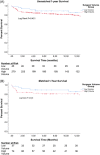In a large-volume multidisciplinary setting individual surgeon volume does not impact LVAD outcomes
- PMID: 35864745
- PMCID: PMC9542019
- DOI: 10.1111/jocs.16783
In a large-volume multidisciplinary setting individual surgeon volume does not impact LVAD outcomes
Abstract
Background: In complex operations surgeon volume may impact outcomes. We sought to understand if individual surgeon volume affects left ventricular assist device (LVAD) outcomes.
Methods: We reviewed primary LVAD implants at an experienced ventricular assist devices (VAD)/transplant center between 2013 and 2019. Cases were dichotomized into a high-volume group (surgeons averaging 11 or more LVAD cases per year), and a low-volume group (10 or less per year). Propensity score matching was performed. Survival to discharge, 1-year survival, and incidence of major adverse events were compared between the low- and high-volume groups. Predictors of survival were identified with multivariate analysis.
Results: There were 315 patients who met inclusion criteria-45 in the low-volume group, 270 in the high-volume group. There was no difference in survival to hospital discharge between the low (91.9%) and high (83.3%) volume matched groups (p = .22). Survival at 1-year was also similar (85.4% vs. 80.6%, p = .55). There was no difference in the incidence of major adverse events between the groups. Predictors of mortality in the first year included: age (hazards ratio [HR]: 1.061, p < .001), prior sternotomy (HR: 1.991, p = .01), increasing international normalized ratio (HR: 4.748, p < .001), increasing AST (HR: 1.001, p < .001), increasing bilirubin (HR: 1.081, p = .01), and preoperative mechanical ventilation (HR: 2.662, p = .005). Individual surgeon volume was not an independent predictor of discharge or 1-year survival.
Conclusion: There was no difference in survival or adverse events between high and low volume surgeons suggesting that, in an experienced multidisciplinary setting, low-volume VAD surgeons can achieve similar outcomes to their high-volume colleagues.
Keywords: circulatory support; heart failure; ventricular assist device.
© 2022 The Authors. Journal of Cardiac Surgery published by Wiley Periodicals LLC.
Conflict of interest statement
The authors declare no conflict of interest.
Figures
References
-
- Molina EJ, Shah P, Kiernan MS, et al. The Society of Thoracic Surgeons INTERMACS 2020 annual report. Ann Thorac Surg. 2021;111(3):778‐792. - PubMed
-
- Gonuguntla K, Patil S, Cowden RG, et al. Predictors of in‐hospital mortality in patients with left ventricular assist device. Ir J Med Sci. 2020;189:1275‐1281. - PubMed
-
- Birkmeyer JD, Stukel TA, Siewers AE, Goodney PP, Wennberg DE, Lucas FL. Surgeon volume and operative mortality in the United States. N Engl J Med. 2003;349(22):2117‐2127. - PubMed
Publication types
MeSH terms
LinkOut - more resources
Full Text Sources
Medical
Miscellaneous




